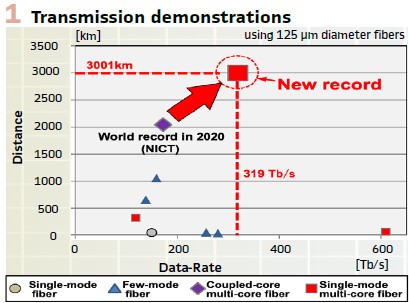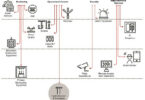by Alex Apostolov, Editor-in-Chief
Over the past decade, intensive research has been carried out worldwide to increase the data rates in optical transmission systems using space-division multiplexing as a means to meet the exponentially increasing demand for optical data transmission.
More recently, interest in fibers with the same 125 µm cladding diameter as standard single-mode fibers has grown due to their compatibility with conventional cabling infrastructure and concerns over the mechanical reliability of larger fibers.
Particularly with multi-core fibers (MCFs), reducing the cladding diameter limits the number of spatial channels, leading to increasing interest in combining such fibers with wider transmission bandwidths in order to meet the expected growth in transmission capacity expected in SDM fibers.
Until now, the National Institute of Information and Communications Technology (NICT) has built various transmission systems that make use of wavelength division multiplexing across the C and L-bands together with state-of-the-art modulation technology to explore high data-rate transmission in a range of new optical fibers. Recently, NICT and research groups around the world have begun to explore S-band transmission, leading to several new records for transmission capacity in optical fibers, but transmission distance has been limited to only a few tens of kilometers. (see Figure 1).
NICT has built a long-distance transmission system around a 4-core optical fiber with a standard cladding diameter to exploit wider transmission bandwidth of >120nm across S, C and L-bands.

The system exploits wavelength division multiplexing (WDM) and a combination of optical amplification technology to enable long-haul transmission of 552 WDM channels from 1487.8 nm to 1608.33 nm. The system was used to measure achievable transmission throughput with each channel modulated with PDM-16QAM modulation at distances up to 3,001 km, where a data-rate of 319 terabits per second was achieved.

This result may be compared to achievements in other SDM fibers and transmission regimes by calculating the product of transmission capacity and distance, often used as a comparison metric. The data-rate x distance product becomes 957 petabits per second x km, which is over 2.7 times larger than previous demonstrations in SDM fibers with standard outer diameter.
Long distance transmission, not previously demonstrated with S-band signals, was enabled by constructing a recirculating transmission loop experimental set-up that combined 2 kinds of rare-earth doped fiber amplifiers with Raman amplification distributed along the transmission fiber itself.
The 4-core MCF with standard cladding diameter is attractive for early adoption of SDM fibers in high-throughput, long-distance links, since it is compatible with conventional cable infrastructure and expected to have mechanical reliability comparable to single-mode fibers. Beyond 5G, an explosive increase from new data services is expected and it is therefore crucial to demonstrate how new fibers can meet this demand.
Hence, it is hoped that this result will help the realization of new communication systems that can support new bandwidth hungry services.
For more detailed information you can visit NICT website at https://www.nict.go.jp/en/press/2021/07/12-1.html since 1982, serving on a variety of Working Groups in both the PES Distribution Subcommittee and PES Switchgear Committee.
Since 2010, Frank has served on the PES Governing Board as Region 1-7 Representative, VP of Chapters, President-elect, and PES President.
He was committed to engaging the next generation of students and young professionals in PES and the industry and was a long-time supporter of the PES Scholarship Plus Initiative. He was also passionate about using technology to bring electricity to people around the world and a strong champion for the IEEE Smart Village Program.








